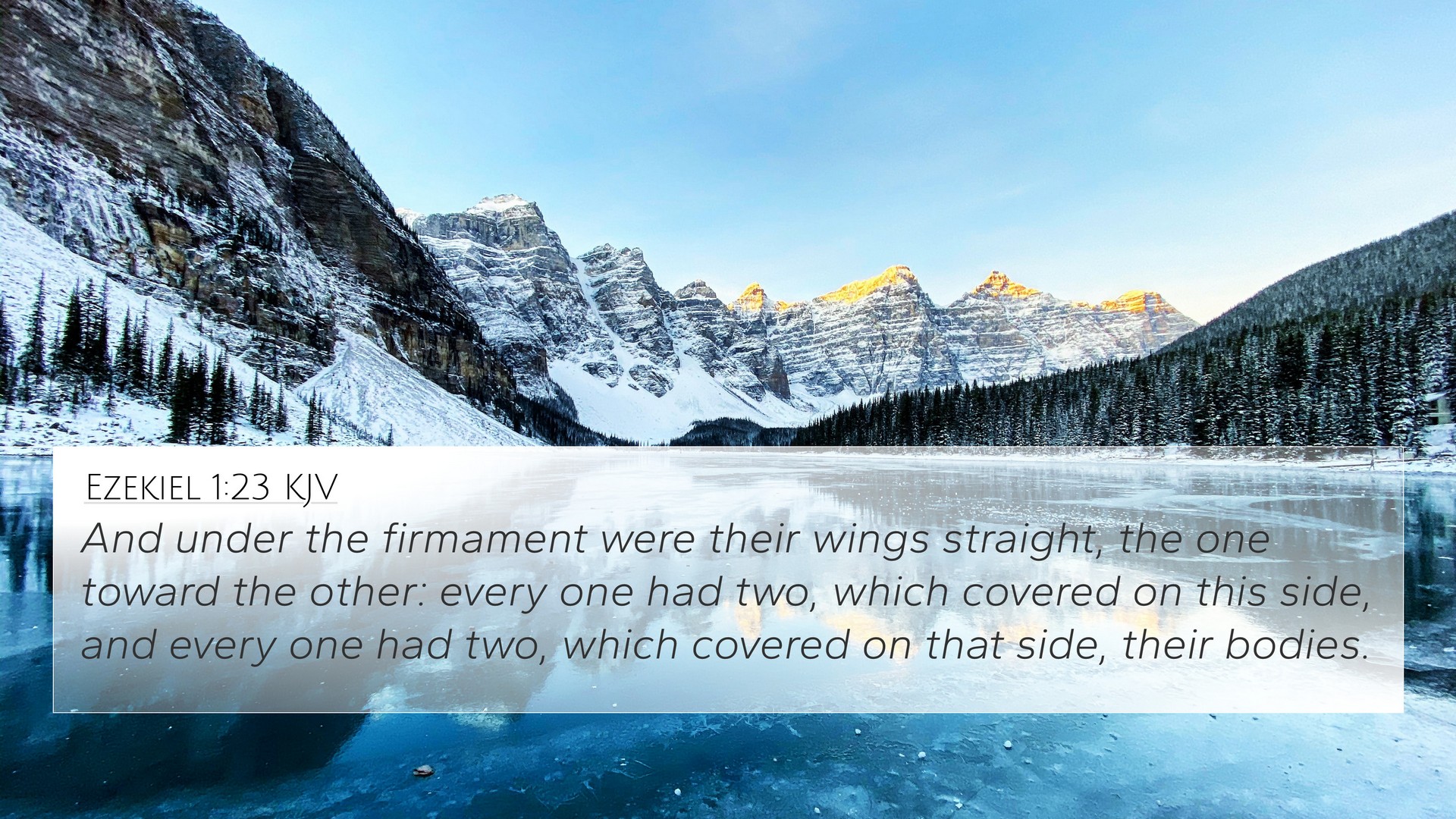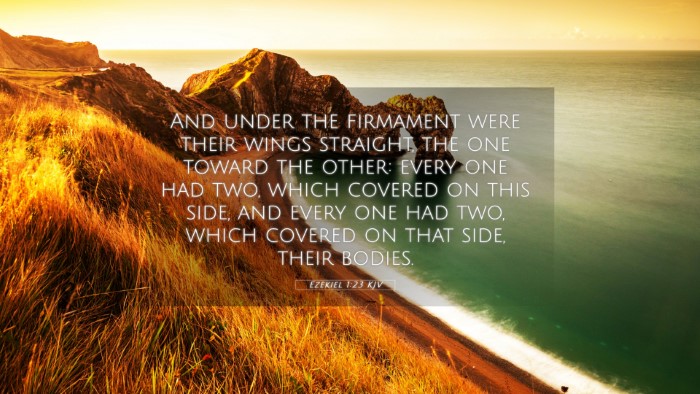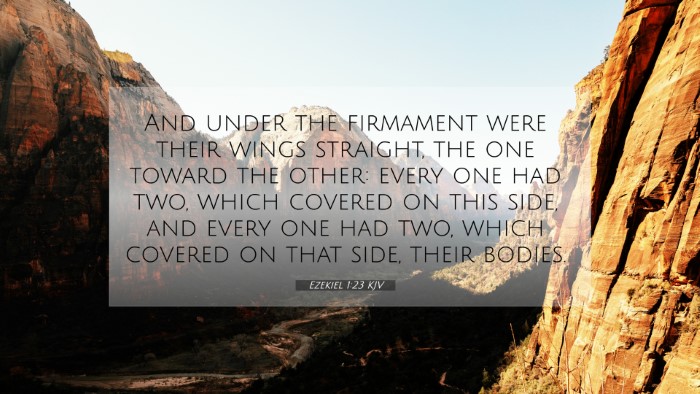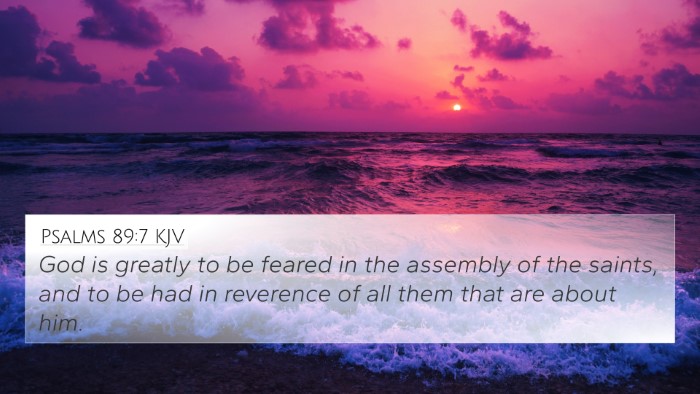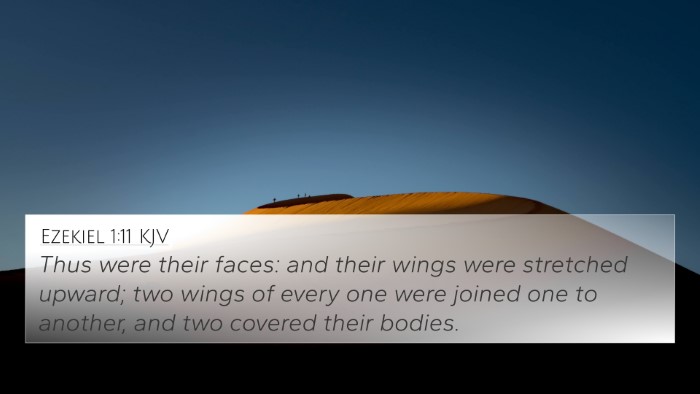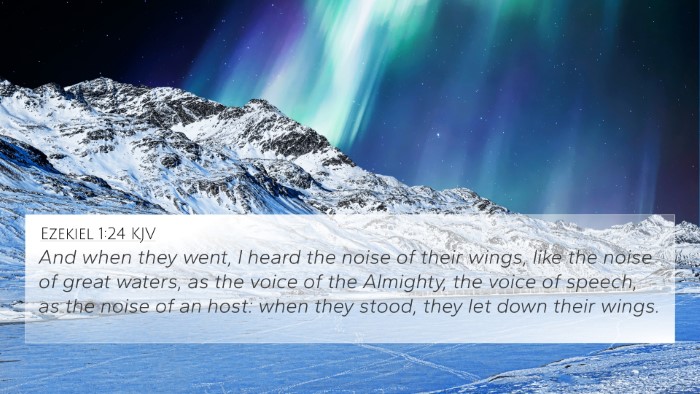Ezekiel 1:23 Explained
Ezekiel 1:23 states: "And under the firmament were their wings straight, the one toward the other: every one had two, which covered on this side, and the other side, their bodies." This verse appears in a profound portion of Ezekiel’s vision of the glory of God, filled with rich symbolism and theological implications.
Overview of Ezekiel’s Vision
The book of Ezekiel presents a detailed account of the prophet's visions, illustrating both God's glory and the execution of His divine purposes. In this particular vision, Ezekiel encounters a remarkable celestial being, often referred to as a 'cherub' or 'living creature.' The imagery in this chapter—particularly in verses like 1:23—serves both a prophetic purpose and a theological exploration of the nature of God.
Commentary Insights
Matthew Henry’s Commentary
Matthew Henry emphasizes the aspect of God’s presence and the reverence commanded by the celestial beings. He notes that the wings signify readiness to serve and present the glory of God, while the structure indicates a form of divine order and symmetry. The wings covering their bodies further symbolize humility, acknowledging the divine majesty and the sanctity of worship.
Albert Barnes’ Notes
Albert Barnes elaborates on the mechanics of the cherubim, focusing on how their wings operate in relation to the firmament. He highlights the way the wings are described as 'straight' and directed toward one another, signifying unity among the heavenly beings and their cooperative service to God. It reflects a connection between the heavenly and earthly realms.
Adam Clarke’s Commentary
Adam Clarke interprets the wings as representations of capacities and actions. He points out that the wings folding over the bodies represent concealment and respect, indicating that even the creatures closest to God recognize their incompleteness before Him. Clarke emphasizes the importance of understanding this vision not just as a narrative, but as a deeper lesson in the nature of servitude and divine glory.
Theological Significance
The wings of the cherubim in Ezekiel 1:23 provide insights into God's holiness and the order within divine affections. The act of covering their bodies suggests an acknowledgment of the sacredness of God’s presence, and invokes a theme that runs throughout scripture—God's otherness and majesty, juxtaposed by His intimate involvement in the affairs of humanity.
Bible Verse Cross-References
- Isaiah 6:2-3: Relates the seraphim and their similar actions of covering themselves in God's presence.
- Revelation 4:8: Describes the thrice-holy creatures surrounding the throne, affirming divine holiness.
- Exodus 25:20: Discusses the wings of the cherubim on the Mercy Seat, which may symbolize protection and divine presence.
- Psalm 104:4: Highlights angels as spirits and ministers, linking heavenly beings to God's creations.
- 2 Samuel 22:11: Describes God riding on the wings of the wind, emphasizing the overlap in imagery.
- Hebrews 1:14: Refers to angels as ministering spirits, relating thematic elements of service and reverence.
- Psalm 91:4: Speaks of God's protection under His wings, integrating the theme of refuge.
- Luke 1:19: Mentions Gabriel, an angelic being, reinforcing biblical depictions of heavenly messengers.
- Ezekiel 10:1-22: Provides additional context about the cherubim and their roles in God's judgment and mercy.
- Jeremiah 51:20: Illustrates God's servants as instruments of divine will, paralleling Ezekiel's themes.
Understanding Connections Between Bible Verses
To grasp the full meaning of Ezekiel 1:23, one must engage in comprehensive Bible cross-reference studies that highlight the thematic connections within the scriptures. The wings are not just a visual portrayal but invite readers to ponder the nature of heavenly realities and their relationship to human worship.
Cross-Referencing Biblical Texts
Effective cross-referencing Bible study provides tools for exploring deeper meanings. For example, understanding the connection between Ezekiel's vision and Isaiah’s seraphim illustrates a consistent biblical theme surrounding God’s holiness. The feathers serve as a metaphor not just for glorification, but also emphasize the necessity of humility in approaching the divine.
Conclusion
In Ezekiel 1:23, there exists a profound invitation to explore themes of divine presence and angelic service in the context of God’s holiness. By utilizing tools such as bible concordances and cross-reference guides, individuals studying this verse can uncover layered meanings that resonate throughout the scripture. Each wing described in this vision serves as a reminder of the intricate connections between heavenly beings and the unfolding narrative of God’s relationship with humanity.
Final Thoughts
The exploration of Ezekiel 1:23 through various biblical cross-references provides a multi-faceted understanding of not only this particular verse but also the overarching themes found throughout the Bible. By identifying the connections between these verses, readers can deepen their knowledge and appreciation of scriptural dialogues across both the Old and New Testaments.
